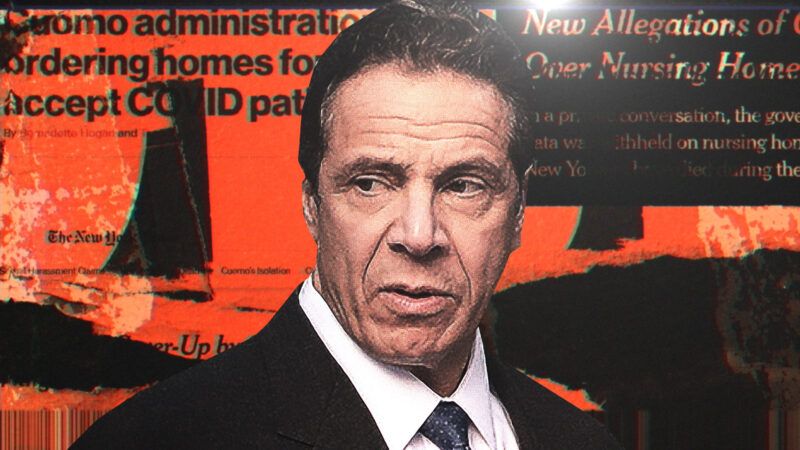Cuomo's Other Victims
How New York's governor botched early-pandemic guidance to residential care facilities for intellectually disabled adults

Embroiled in scandal for the better part of this year, New York's Democratic Gov. Andrew Cuomo has yet another major problem on his hands.
In January, state Attorney General Letitia James brought to light the fact that nursing home deaths were thousands higher than the Cuomo administration had reported, and that the governor's March 25 directive "may have contributed to increased risk of nursing home resident infection and subsequent fatalities." (More than 4,000 people died after the directive was issued.) Just weeks later, top Cuomo aide Melissa DeRosa admitted privately to fellow Democrats that the administration had covered up the true death toll in nursing homes, hoping not to invite a Department of Justice investigation.
Now, publications such as The Wall Street Journal, the National Review, and the New York Post—but not The New York Times, which for many months held off on substantially covering the March directive and calls for release of the true death toll—report that Cuomo's nursing home directive wasn't the only ill-advised guidance issued. He also issued an April 10 directive that similarly instructed residential homes for adults with intellectual and developmental disabilities to accept asymptomatic COVID-19 patients back into congregate living facilities, in some cases without sufficient testing and isolation protocols in place.
The memo, which remains in effect today, explicitly specifies that "providers of Certified Residential Facilities are prohibited from requiring a hospitalized individual, who is determined medically stable, to be tested for COVID-19 prior to admission or readmission." (Emphasis mine.) It also says that "residents who are symptomatic should only be discharged to a certified residence if there are clinical staff available who are capable of attending to the medical needs of a symptomatic resident," which invites questions about how facilities were distinguishing between symptomatic and asymptomatic patients, and how the protocol varied when actually put into practice.
Republicans in the state Senate say Cuomo, who is nothing if not consistent, may be obscuring information on total death tolls in these homes, just as he did when inundated with public records requests for death tolls in homes for the elderly. New York's Office for People With Developmental Disabilities said in a statement that "residents of OPWDD group homes who were sent to the hospital for COVID-19 treatment were returned to their homes after being deemed safe to return by the hospital physician, in consultation with the residential provider." They report 553 confirmed deaths out of 6,952 confirmed positive cases in these residential facilities.
Family members of adults with disabilities say that those who live in these care facilities struggled with disruptions to routine that came around the onset of the pandemic and have persisted for nearly a whole year. Many take part in some form of daytime programming, which has been made unavailable. Some people with intellectual and developmental disabilities struggle with mask wearing, failing to understand why it even needs to happen in the first place. Families across the state were barred from seeing their loved ones in person for many months; local news accounts are replete with stories of intellectually disabled adults not understanding why in-person visits with parents, siblings, and friends had ceased. For many families, Zoom and FaceTime made for an insufficient stand-in, as some people with disabilities struggled to make sense of the technology and couldn't reap the same benefits of feeling connected to their loved ones through a screen.
Danielle Platt Lewis' family was directly harmed by the directive. Two of her aunts, both in their 60s, and one uncle (a decade younger) lived in Long Island group homes, and all three of them contracted COVID there. Both aunts passed away, but her uncle survived. "This was a nightmare of an experience for our family," she tells Reason.
"Losing two family members who should have lived longer lives is so hard to understand especially when we learned that there was a directive to place symptomatic individuals back in homes. They still had to share bathrooms and could not avoid infecting others," she says. Her dad, William, even had to "defend the sanctity and value of her [aunt's] life to doctors in charge of her care" at the hospital and says he wishes he'd taken them out of their group homes and brought them down to North Carolina, where he lives.
Liz Devoti, whose two brothers live in group homes in Rockland County and both contracted COVID, says Cuomo's "rules on group homes were and are unfair," and that his administration and OPWDD "abandoned the most vulnerable leaving not for profit agencies fending for themselves."
Did Cuomo do the same thing to disabled people that he did to the elderly? With better guidance to properly test and isolate COVID patients to stave off the spread, many subsequent deaths might have been avoided.
Cuomo is currently facing calls for impeachment from both Democrats and Republicans, especially as a sixth woman has emerged alleging that the governor sexually harassed her, this time by groping her after summoning her to his private residence. As Cuomo deals with the messy fallout, New Yorkers should remember that his misdeeds have become almost too numerous to count and that many people's lives have been affected—or ended—as a result of his early-pandemic directives, some of which remain in place today.


Show Comments (69)